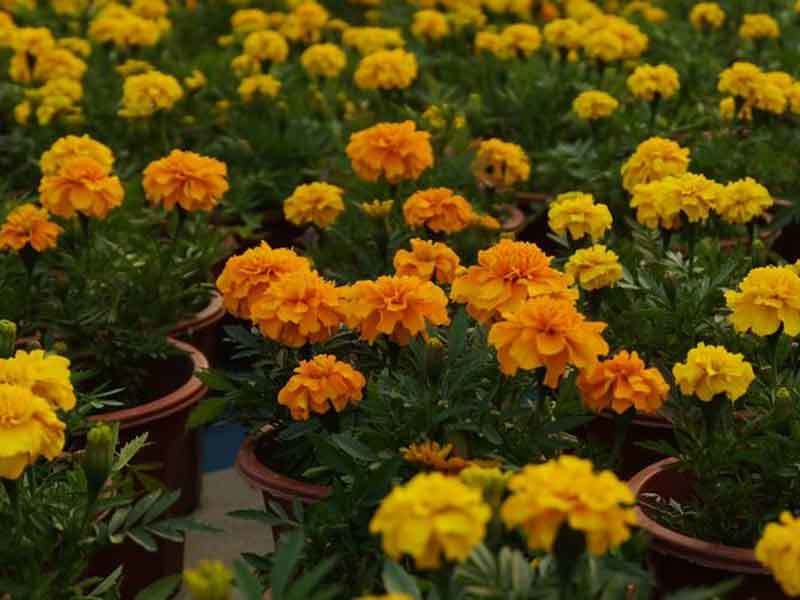Marigold Leaves Turning Purple: Causes and Remedies
Introduction
Marigolds are hardy plants. But environmental factors can still affect them. Understanding the causes and remedies for marigold leaves turning purple. You can keep your plants healthy and vibrant.
Why are My Marigold Leaves Turning Purple?
Seasonal Changes
Marigolds are annual plants. They complete their entire life cycle in one year. This includes going through different growth stages and changing with the seasons. Marigold leaves turning purple in the fall is not unusual.
Sunlight becomes less abundant and temperatures drop during this time. Plants slow down their photosynthesis process. Chlorophyll production decreases and other pigments become more prominent. For example, anthocyanins. This can give marigold leaves a purple or reddish tint.
Environmental Factors
Temperature Fluctuations: Extreme temperature changes can have a significant impact on the color of marigold leaves. When exposed to extreme hot or cold temperatures, the marigolds leaves may turn purple. This discoloration occurs as a protective measure. This discoloration occurs as a protective measure. It is against stress caused by temperature fluctuations.
Sunlight Exposure: Excessive sunlight can also cause purple discoloration in marigold leaves. The chlorophyll production may decrease when marigolds receive too much sun exposure. When marigolds do not receive enough sunlight, they produce more anthocyanins. This type of pigment gives the leaves their purple color. This can happen if sunlight reduces or you do not plant marigolds in an optimal location.
Soil Issues
pH Levels: An imbalanced soil pH can affect the absorption of nutrients. For example, too high pH level can lead to a phosphorus deficiency. This causes marigold leaves to turn purple.
Nutrient Deficiencies: It can also contribute to marigold leaf problems. Lack of phosphorus and potassium can cause discoloration of leaves. They are very important for plant growth.
Watering Issues: Inconsistent watering can lead to stress on the plants. They will be susceptible to nutrient deficiencies and diseases. Overwatered marigold leaves may turn purple.
Pests and Diseases
Aphids and Other Insects: One of the most common culprits behind purple marigold leaves is aphids. These small insects feed on the sap of the plant. They damage the leaves and stems. As a result, the affected leaves may turn purple or even wilt.
Thrips, leafhoppers, and whiteflies can also cause stress to marigold plants. They can lead to marigold leaves turning purple. Regularly check for signs of insects. Take appropriate measures to control their population.
Fungal Infections: Fungal infections can also cause marigold leaves to turn purple. They can manifest as small spots on marigold leaves. They may eventually spread and cover a larger area. For example, leaf spot marigold diseases. The fungus attacks the cells and inhibits it to produce chlorophyll.

Genetic Variations
There are also genetic variations that can cause marigold leaves to turn purple. Certain varieties of marigolds have been bred to naturally exhibit purple foliage as part of their unique characteristics.
The most common variety is the Tagetes Patula, also known as the French marigold, which has purple-colored leaves and flowers. Another variety that can exhibit purple foliage is the Tagetes Erecta, or commonly known as African marigold. Some cultivars have been developed to also have purple leaves.
These genetic variations have been achieved through selective breeding and hybridization. Certain pigments responsible for the purple color are present in higher amounts. This results in a stronger expression of the pigment, giving the leaves a vibrant purple hue.
Remedies for Marigold Leaves Turning Purple
Adjusting Soil pH
Marigolds prefer a slightly acidic soil. Make sure the soil pH is 6-7. Purchase a testing kit from your local garden center. You can also use a DIY method. For example, vinegar and baking soda. You can add lime to raise it if the soil pH is lower than 6. You can add organic matter to lower it if the pH level is higher than 7. For example, compost or peat moss.
Fertilization
Choose a fertilizer with equal NPK ratio. Apply the fertilizer according to the package instructions. Usually once a month during the growing season. Water your plants before and after fertilization to prevent root burn. Avoid using high-nitrogen fertilizers which can promote excessive leaf growth.
Consistent Watering
You should choose well-draining soil. Before planting, thoroughly moisten the soil with water. After planting, water deeply once a week, making sure to soak the roots. In hot weather, check daily and water if needed.
Organic Pest Control
To naturally control these pests, you can try using organic methods. For example, introducing beneficial insects like ladybugs, lacewings, and parasitoid wasps to your garden. You can also make a homemade spray to repel pests. For example, garlic, neem oil, or peppermint oil. For example, garlic, neem oil, or peppermint oil.
Fungal Treatments
Overwatering, poor air circulation, or excessive humidity can cause these. To treat fungal infections organically, you can use a variety of fungicides. For example, copper-based products, sulfur sprays, or compost tea. Regularly monitor your plants. Remove any infected leaves or flowers to prevent the spread of the fungus.
Mulching
Apply mulch around the base of each plant. Leave a few inches between the stem and the mulch. This will retain soil moisture and keep it from drying out too quickly in hot weather. Mulch can moderate soil temperature and protect the roots from extreme heat or cold.
Selecting Resistant Varieties
These varieties are bred specifically for their ability to resist common marigold leaf diseases and pests. Some popular options include Safari, Bonanza, and Moonsong Deep Orange.
Conclusion
Regularly monitor your plants and make adjustments as needed. Ensure they get the proper care they need. Your marigolds will continue to add a pop of color to your garden or landscape all season long.

